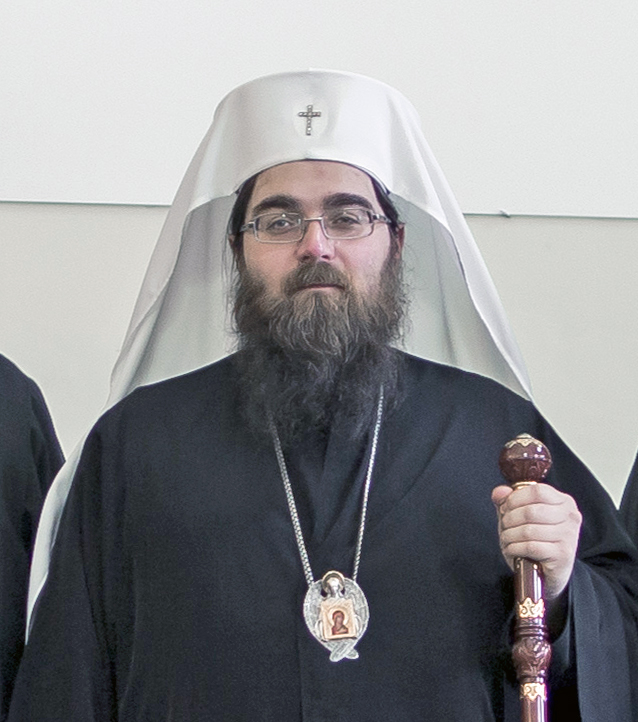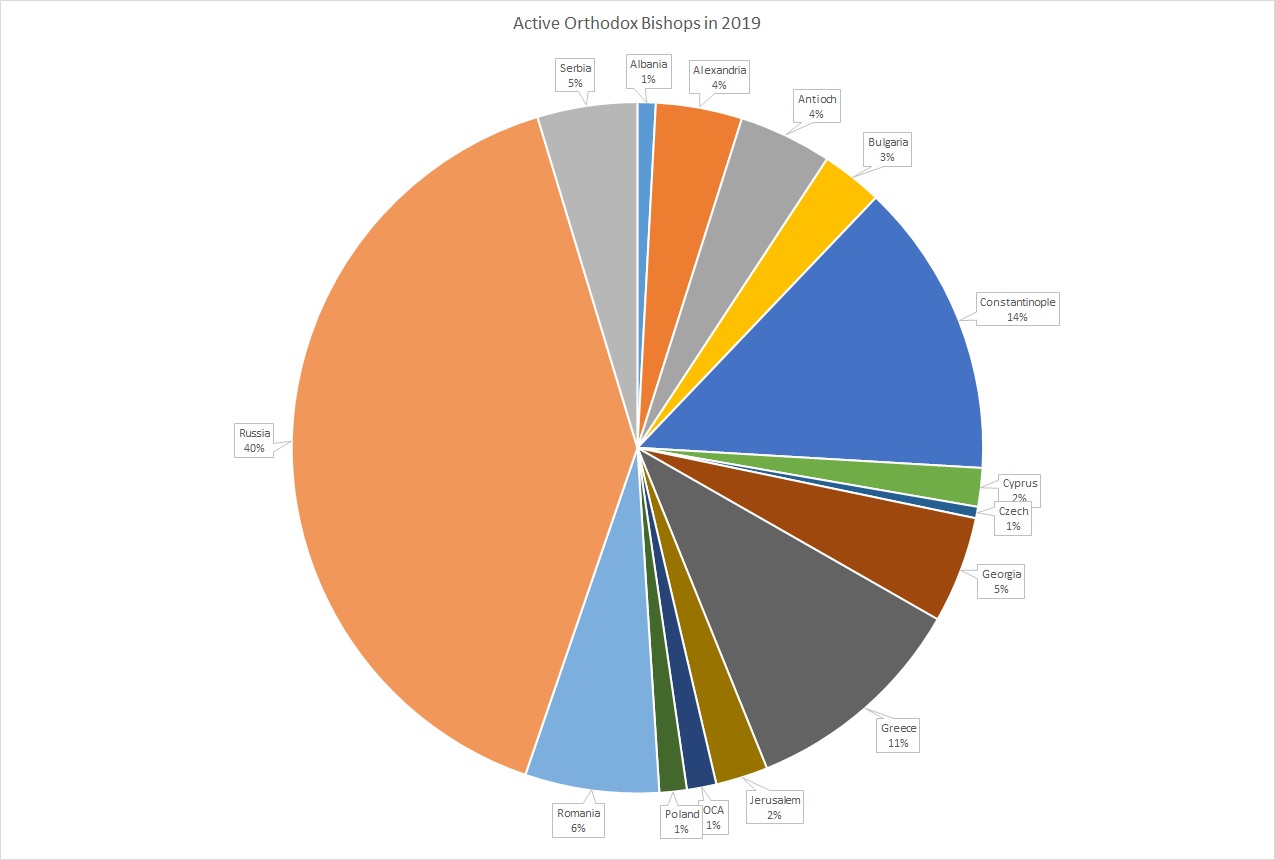
Metropolitan Rastislav, primate of the Orthodox Church of the Czech Lands and Slovakia, which has just five active bishops — the fewest of any autocephalous Church.
As best I can tell, there are 941 active, canonical Orthodox bishops in the world right now. Give or take.
Compared to the 19th century, that’s a big increase — in 1859, we had just 278 bishops worldwide. But at the time of the First Ecumenical Council, there were a reported 1,800 bishops in the world — about 1,000 in the East and 800 in the West. And that’s for a much smaller population of Christians.
The largest share of the world’s bishops, by far, belongs to the Moscow Patriarchate, at 40% — 377 bishops (including the bishops of the Ukrainian Orthodox Church and ROCOR, among others). Next is the Patriarchate of Constantinople at 14% (130 bishops) and the Church of Greece at 11% (100 bishops):
Accurate population data for Orthodoxy is notoriously difficult to come by — it all depends on how you define “Orthodox.” But I did my best to track down population data for the various Orthodox Churches in the world, and it adds up to about 222 million Orthodox Christians worldwide (which, to be honest, is probably on the high end). That works out to 236,000 people per bishop, which seems just absurdly high. Interestingly, though, that ratio is identical to the ratio of people to bishops in 1859 — 236,000 to 1. That’s a big change from the time of Nicaea, when the ratio was somewhere between 5,000 and 20,000 to one.
The people-to-bishop ratio varies a lot among the various Churches — the Churches of Russia, Romania, Bulgaria, and Serbia all have incredibly high ratios, well over 150,000 to one. The OCA and the Alexandrian, Czech, and Jerusalem Churches are all under 20,000, closer to the way things were at the time of Nicaea. Of course, a lower ratio doesn’t necessarily mean more pastoral care — Jerusalem (and Constantinople, with a ratio of around 26,000 to one) has a lot of active bishops who are serving in some kind of administrative role, not actively tending flocks.
As I said, globally, the ratio of people to bishops is identical today to what it was in 1859. But back then, there was far more variation among the Churches — Russia’s ratio was an outrageous 769,000 to one, while Alexandria and Jerusalem were both at just 1,000 to one.
Overall, to get back to Nicaean-era ratios, we’d need more than ten times as many bishops as we currently have. Obviously that’s not going to happen — we would need 10,000+ bishops, when we actually have less than 1,000. I’d be surprised if there were 10,000 men on earth who are both canonically eligible to be bishops and are remotely suited for the job. But then, in the days of Nicaea, the role of the bishop wasn’t exactly what it is today. For better or worse, it has evolved from a locally-focused pastoral position to more of a high-level administrative job.


Where did the information come from,,,,I consider the yearbook/ directory orthodoxia the best,,,,,what is your opinion
Orthodoxia is a fantastic source. For this study, my main sources were the lists of bishops on the individual Churches’ websites, and/or the data reported by those Churches. Orthodoxia includes retired bishops and many recently-deceased bishops, which makes it more difficult to use — it would require going through each of the 1000+ bishops in their database and determining which are active.
And how do you calculate the flock ?
I relied mainly on the individual churches’ estimates, which I realize aren’t reliable. In some cases, government census data includes religious affiliation, so that was useful.
Caro Matthew, muito interessante este trabalho. Poderia nos dar permissão para tradução ao português e publicação em nosso site?
Yes, you are welcome to translate and publish in Portuguese. Thank you for asking.
My follow-up article, published today, includes updated data on the number of bishops. My current estimate is 947.
tbh, Russian wikipedia has up-to-date lists of bishops of all 16 local Churches, in chronological order, inlcuding retired and former ones
How might I find a list of names of all of the 941 Bishops and their addresses? I would love to send them a letter
I made some rapid calculations, using the Greek, Russian and Romanian churches. In orders of magnitudes (I think it’s the most relevant here given the high diversity betwenn churches), as you said, there are 1 bishop for every 100k Orthodox Christian, wich seems a lot. howewer, among those 100k are all people affiliated to Orthodoxy, perhaps some even without being baptized, nor even having been to a church, but only self reporting.
One more relevant information would be the number of practicing (weekly or so) orthodox by bishop. It appears that, in those three exemples I have investigated, the order of magnitude is around 10% of the affiliated orthodox being seriously practicing orthodox (closer to 20 for Greece, closer to 5 for Russia), that is, roughly 10 000 seriously practicing Orthodox per Bishop.
What about the number of priests and parish ? In order of magnitude, there appear to be quite neetly in the middle between bishops and serious practicers. 100 parishes per bishop (Russian church : ~40 000 priest/parish, ~400 bishops, Greek church ~10 000 priest/parish, ~100 bishops), and 100 seriously practicing orthodox per parish.
This rule of thumb seems mostly accurate, and for my own country of France, with our ~300 parishes, we would have 30 000 practicing orthodox and 300 000 affiliated orthodox, wich would seem accurate. Of course we have many more bishops than 3, because of the diaspora situation.
There are ~3 000 parishes in the USA, wich would mean 300 000 practicing orthodox and 3 000 000 loosely affiliated, wich seems also quite reasonable in orders of magnitudes.
Now some reflexions about it : One bishop per 100 parishes seems at the same time quite proper, but also quite not enough bishops. How difficult would it be to visit each parish each year ! There are only 50 sundays in a year, after all. But I think what we need is not necessarily more bishops, but an intermediary between the priest/parish and the bishop, the could serve as some kind of limited bishop, serving 10 parishes out of the 100. More than a dean or a protopresbyter, someone that would be truly a bishop, with a pastoral role
That role, howewer, did historically exist ! They are named chorepiscopoi, village bishops. They were suffrageant to a proper diocese, and they add the permission to order lower clergy, but not priest, deacons and bishops (although they add technically the power to do so). There were sometines village bishops for localities so little as 12 inhabitants ! I think they should be reimplemented in the basis that I described : one for ten parishes, with limited ordaining power, and perhaps we could allow them to be chosen among the married (altough celibate could be preferable)
Another intermediary should be between the priest and the laity. I attend a very small parish, with ~20 weekly attendants, so the priest is able to provide much care for everyone. But that is a luxury ! If there are 100 people on average in a parish, for every 10 people on average the priest should ordain some kind of pastoral delegate. Minor orders used to be way more pastoral, and now they are seen as quite solely liturgical. But both subdeacons and their female counterparts, deaconess, had a pastoral role, of intermediary of the priest, of a trusted member of the community.
Of course, at the end of the chain, the communing orthodox christian is the one in charge of giving witness of his faith to not only the non christians, but most importantly, the orthodox who may not be as serious in their belief and practice.
Now another issue, nearer to the top : Metropolis (real ones, not on paper ones) have had a tendency to disapear in many juridictions, such as Greece or Antioch. They should come back, as they are the basic and most traditionnal way or organizing the church.
So the organization of the church should be as follow (in orders of magnitude)
1 church
10 patriarchates
100 metropolis
1 000 bishops
10 000 chorepiscopoi/dean
100 000 priests/parishes
1 000 000 delegates/subdeacons/minor clergy
for
10 000 000 weekly attending orthodox christian
100 000 000 orthodox christians
It would be, I think, much more coherent and pastoraly fitting
Of course, the goal is always to expand the number of orthodox christians, and of practicing ones among the affiliated.